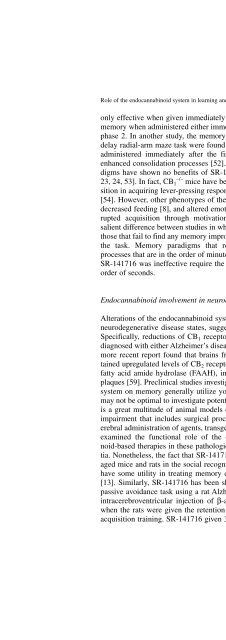3. Umbruch 4.4..2005 - Online Pot
3. Umbruch 4.4..2005 - Online Pot
3. Umbruch 4.4..2005 - Online Pot
Create successful ePaper yourself
Turn your PDF publications into a flip-book with our unique Google optimized e-Paper software.
Role of the endocannabinoid system in learning and memory 121<br />
only effective when given immediately before phase 1, and failed to enhance<br />
memory when administered either immediately after phase 1 or 30 min before<br />
phase 2. In another study, the memory-enhancing effects of SR-141716 in a<br />
delay radial-arm maze task were found to be dose-related and occurred when<br />
administered immediately after the first session, suggesting that the drug<br />
enhanced consolidation processes [52]. However, studies using operant paradigms<br />
have shown no benefits of SR-141716 treatment on performance [20,<br />
23, 24, 53]. In fact, CB 1 –/– mice have been reported to display impaired acquisition<br />
in acquiring lever-pressing response using a simple fixed-ratio schedule<br />
[54]. However, other phenotypes of these mice, including, hypomotility [55],<br />
decreased feeding [8], and altered emotionality [56], may have indirectly disrupted<br />
acquisition through motivational or sensorimotor alterations. One<br />
salient difference between studies in which SR-141716 enhances memory and<br />
those that fail to find any memory improvement is the temporal components of<br />
the task. Memory paradigms that reveal enhancement require memory<br />
processes that are in the order of minutes or hours, while the studies in which<br />
SR-141716 was ineffective require the retention of information that is in the<br />
order of seconds.<br />
Endocannabinoid involvement in neurodegenerative diseases<br />
Alterations of the endocannabinoid system have been reported in at least two<br />
neurodegenerative disease states, suggesting the involvement of this system.<br />
Specifically, reductions of CB 1 receptors were reported in brains of patients<br />
diagnosed with either Alzheimer’s disease [57] or Huntington’s chorea [58]. A<br />
more recent report found that brains from Alzheimer’s disease patients contained<br />
upregulated levels of CB 2 receptors, as well as increased expression of<br />
fatty acid amide hydrolase (FAAH), in microglia associated with β-amyloid<br />
plaques [59]. Preclinical studies investigating the role of the endocannabinoid<br />
system on memory generally utilize young, healthy animals, which arguably<br />
may not be optimal to investigate potential nootropic agents. Conversely, there<br />
is a great multitude of animal models of cognitive dementia and/or memory<br />
impairment that includes surgical procedures, traumatic brain injury, intracerebral<br />
administration of agents, transgenic mice, and drugs. Few studies have<br />
examined the functional role of the endocannabinoid system or cannabinoid-based<br />
therapies in these pathological states or animal models of dementia.<br />
Nonetheless, the fact that SR-141716 attenuated the deficits displayed by<br />
aged mice and rats in the social recognition task suggests that this agent may<br />
have some utility in treating memory deficits that are associated with aging<br />
[13]. Similarly, SR-141716 has been shown to prevent memory deficits in a<br />
passive avoidance task using a rat Alzheimer’s model [60]. In this model, an<br />
intracerebroventricular injection of β-amyloid fragments disrupted memory<br />
when the rats were given the retention test 1 week, but not 1 day, following<br />
acquisition training. SR-141716 given 30 min prior to a 1-week retention test







